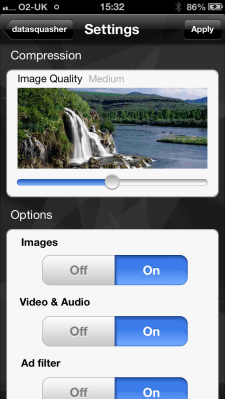The irony of the UK rolling out its first “super fast” 4G network last week, courtesy of EE, won’t be lost on consumers for too long: we can now burn through our rationed mobile data plans even faster. It’s unsurprising, then, that a number of startups have emerged over the last year or so with ways to help reduce our mobile data usage by compressing traffic on the fly, proxy-server style.
Millenoki, based in the UK, is offering to do just that with its newly-launched iPhone app, datasquasher, which enables users to monitor and take control of their mobile data usage, reducing it along the way. It’s not a new idea, however, with a number of fairly well-known competitors, such as Onavo, and Snappli, both of which are VC-backed, while Millenoki has received an undisclosed amount of angel funding from angel investor Charles Buchan.
Similar to its competitors, along with handling that potentially money-saving mobile data compression, and offering ways to tweak any compression trade-off (e.g. adjust the quality of images on web pages), the datasquasher app enables users to track their monthly data usage or interrogate usage over a specific period of time. In addition, if they are using too much data, datasquasher will send them a message to let them know and they can modify their browsing and downloading behaviour. Interestingly, it also claims to block malicious sites, adding another layer of security.
The idea behind datasquasher came from founder Dan Field’s prior experience working on ClearMyMail, an anti-spam solution for email, which included offering compression within emails.
As for the business model behind Millenoki’s datasquasher iPhone app — at launch the service will be free, however, as new features are added it is expected that a small subscription fee will be charged. I’m assured, however, that a user’s browsing data will never be sold, instead it’s hoped that the app’s offering, over time, will be enticing enough to have users reaching for their pockets.
There’s another potential revenue stream, of course. Selling the service directly to virtual mobile operators who, I gather, buy their data allowance wholesale. In that context, getting more bang for your buck doesn’t just make sense for consumers.
